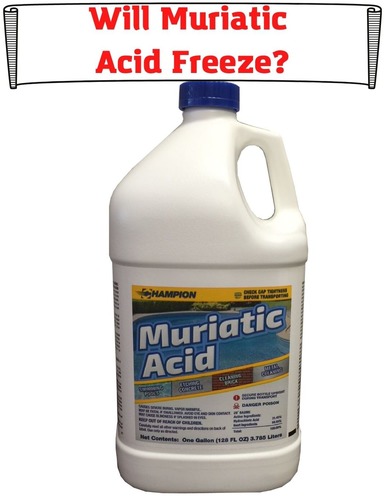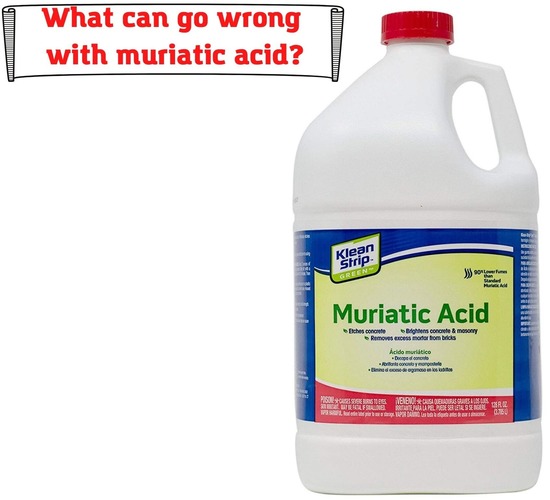
Muriatic acid is quite a popular solution for many projects. We mean not only painting projects but also other home things that you may want to do. This liquid is great for cleaning off mold, prepping some surfaces before painting, etc. This is a very strong chemical solution, though, and you must be extremely careful when using it.
To begin with, we don’t recommend using muriatic acid if you have any other less dangerous alternatives. But if you have no choice, please read our today’s article. We’ll give some precautions that must be taken when working with muriatic acid and also many other acid types.
In this article you will learn:
- Does muriatic acid ever freeze?
- How can you store the acid for a long time?
- What are the risks for your health when using muriatic acid?
- What are the main purposes of the acid?
- How to apply and how to protect yourself when using it?
Let’s get started!
What is the freezing temperature of muriatic acid?
This is the most common question we are usually asked, so we decided to answer it at the beginning of our article. Basically, muriatic acid is a mix of mineral acids that is capable of impacting basically anything: paint, primers, concrete, mold, dirt, your skin, etc.
The acid is very affordable. You will pay as little as $10 for a gallon of this liquid. And this makes muriatic acid one of the most affordable prepping products in the world of painting. Though, don’t stop reading and don’t go to Amazon to buy a couple of buckets until you know what can happen if you do something wrong.
So, muriatic acid is a mix of mineral acids that can freeze at the temperature of -51 degrees Fahrenheit (-46 degrees Celsius). This is the freezing point of most muriatic acid types. By types, we mean producers because they can use slightly different formulas in their products and this will move the freezing point to any side. But in most cases, you can store the acid even outside, it won’t freeze.
How to store the muriatic acid?

The acid isn’t that temperature-sensitive until you put it in a freezer with temperatures under minus 50 degrees. Many people are concerned about whether they can store muriatic acid outside when it’s hot. Yes, you can, you will only need to make sure it’s sealed properly. Otherwise, some fumes will still be there and you will breathe them which isn’t good at all.
You shouldn’t store the muriatic acid for more than 1 year. This is a shelf life that most manufacturers show in their documentation. No need to store the acid inside your house. It’s a very bad idea because if you don’t seal it correctly or someone opens this acid by chance, you may get poisoned and have severe health issues. Better keep it in a garage or just outside.
How to apply muriatic acid?
As you may know, we are the blog about painting. So we use muriatic acid to clean up the surface before painting. This may be a concrete wall or something. Usually, the acid is used for this purpose in house decoration. No need to apply the acid for paint prepping in any other areas. You will get a lot of wonderful alternatives.
Here’s what muriatic acid may do well:
- concrete walls prepping before you are going to paint them;
- taking off old paint from concrete or other surfaces;
- taking off the primers that you don’t need on a surface.
But professionals would say that this is very unprofessional to recommend muriatic acid for any of these spheres. You can get other alternatives that work quite well but don’t harm you much in case you do something wrong. You should go to alternatives whenever you have a chance.
What can go wrong with muriatic acid?
Here, we tried to gather the most dangerous effects muriatic acid can have. It’s not only bad for people, it can also be bad for the surface that you want to clean and prepare for painting or any other decoration.
Here are some of the worst consequences of using muriatic acid:
- Burned skin. The acid can easily burn your skin when coming in contact with it. Be careful and don’t ever allow the acid to get onto your skin even for a while.
- Eye irritation. Well, it’s not only irritation but some irreversible diseases that can ruin your eyesight. A person may even get blind if a lot of acid gets to the eyes.
- Lung burns. If you inhale the fumes of muriatic acid, you may burn some tissue in your nose and lungs. Sometimes people will even need medical help.
- Spoiled clothes. Muriatic acid easily burns clothes and spoils the color. The white stains will be there forever and you won’t be able to do anything with them.
- Fainting and dizziness. If you inhale a lot of muriatic acid fumes, you may feel dizzy or even faint. Also, you may get poisoned heavily if you don’t get fresh air immediately.
As you see, muriatic acid is not a joke. Don’t ever allow children or pets to be in contact with the acid and store it in a safe place so that nobody would even think of opening the bottle and smelling or drinking it. If drunk, the acid will cause severe poisoning and probably even the death of a person.
Be on the safe side – ways to protect yourself
You may know that many people use muriatic acid for swimming pool maintenance. It’s the cheapest chemical they can get for cleaning off some mold, dirt, and algae that can be in the pool. But when you work in an empty pool you don’t always get a lot of fresh air. So yearly some people die because of muriatic acid intoxication and poisoning.
We will provide a list of must-do factors if you work with this acid:
- Wear protective clothes and a protective respirator as well as protective glasses. This will help you avoid having any contact with the acid.
- Ventilate the place where you work. Ventilation is the key to not feeling bad after working with toxic solutions of any kind.
- Always dilute the acid with water (1 acid to 10 water parts or whatever you need).
- Avoid mixing muriatic acid with any other chemicals. This can bring unpredictable consequences.
- Never store the acid in any other container but the factory bottle.
- Never get rid of muriatic acid in any other way than calling a recycling company and asking them what you need to do to recycle it properly.
- Always use the instruments that are meant to be used in contact with acids.
- Always keep a lot of fresh water nearby so that you could quickly wash your skin or eyes in a large amount of water if they come in contact with the acid.
If you spill the acid over the floor, use baking soda to neutralize the chemicals. What you need to do is to cover the acid with baking soda carefully so that the reaction of neutralization occurred. After a while, you can clean the stain with a lot of fresh water.
What happens if muriatic acid freezes?
As we’ve told you before, muriatic acid will freeze at a very low temperature only. But if you have a kind of solution (so-called half-strength muriatic acid), it can freeze at -15 degrees Celsius which is quite possible in many states. So, if it actually freezes, it will lose its chemical value and won’t work well after melting. You shouldn’t use your muriatic acid after it was frozen.
If you don’t want the acid to freeze, better keep it in your garage, but never take it home. If the bottle is broken or damaged, the fumes will quickly fill the entire room and will make it very dangerous for people to be there. So, your garage is a perfect place for storing muriatic acid. But make sure no one has access to it to ensure that no curious person will try to smell it or use it for any purpose.
Final words
Now you know that the freezing point of the muriatic acid allows you to store it outside in most states for most of the years. But if the acid was frozen, just call the company that deals with waste and ask what you should do to get rid of the acid that is no longer good for use.
Muriatic acid is most often used for swimming pool maintenance. But sometimes it’s also used in interior painting when redecorating homes and flats. It cleans off mold and old paint, helps in prepping. Though, be very careful when using this chemical because it’s highly dangerous for a person. Call for medical help anytime you have any contact with muriatic acid.
- Can You Unmix Paint: Techniques, Consequences, Alternatives - February 23, 2024
- Does Primer Need to be Mixed? Effective Primer Application - February 22, 2024
- How to Make Old Paint Usable Again: Retrieving and Preserving Paint - February 21, 2024




